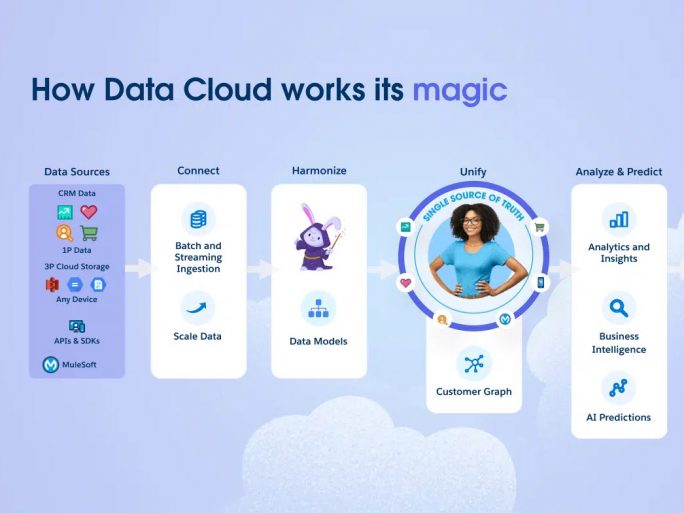Salesforce Data Cloud, the Platform That Solves Data (and Departmental) Fragmentation

The fastest growing product in Salesforce’s history closes the loop on enterprise data management with a heavy dose of generative AI through Einstein Copilot Studio.
Salesforce Data Cloud has its roots in Salesforce’s vision to democratise access to data and provide tools that enable companies to better understand their customers. The platform officially launched in 2012 as Data.com, the product of Salesforce’s acquisition of Jigsaw Data Corporation, a company that specialised in building and managing business contact databases.
Following the acquisition, Salesforce Data Cloud became a key component of Salesforce’s strategy to enable organisations to enrich their existing data with accurate and up-to-date contact information. The platform facilitated the integration of third-party data into Salesforce CRM, enabling companies to access a wide range of external data to improve their sales and marketing processes.
Over time, Salesforce Data Cloud evolved beyond simple contact lists to become a comprehensive data management and activation solution. The platform expanded to include demographic data, online behavioural data, social data and more, all to provide companies with a holistic view of their customers (existing and future).
“At the time, we realised that all that data was extremely fragmented,” Ryan Strynatka, SVP & COO, of Salesforce Data Cloud, told us at a meeting at the Salesforce World Tour conference in Madrid last week: “If you think about the different business categories and departments, there’s a lot of fragmentation. So in 2019, we set out to focus on bringing all that data together.

The integration of the Salesforce Data Cloud with other Salesforce solutions, such as the Salesforce Marketing Cloud, Salesforce Sales Cloud and Salesforce Commerce Cloud, was a crucial step in its evolution. This led to the creation of Salesforce Customer 360, a unified platform that enables companies to connect all customer touchpoints and leverage accurate, up-to-date data to deliver personalised, relevant experiences.
Salesforce Customer 360 uses Salesforce Data Cloud technology to consolidate and enrich customer data in real-time, enabling companies to better understand their customers’ needs and preferences. This integration has been instrumental in driving the adoption of customer-centric strategies and improving customer loyalty over time.
“The idea was to have a federation of both inbound and outbound data to build flexible solutions that fit into the workflow of organisations,” added Strynatka. The key to Salesforce Data Cloud, in addition to being cloud-native, is to mix data storage internally with access to external sources without having to replicate that information, which Salesforce calls ‘Zero Copy Architecture’. This includes transactional data that is being generated or changing all the time, as well as data from traditional ‘Legacy’ systems: “Unifying ‘online’ data with ‘at rest’ data helps significantly in unlocking all kinds of new creative use cases to drive better customer experiences and, therefore, better business outcomes,” he said.
Such an avalanche of information available to an organisation’s employees creates another problem: how to process it efficiently to improve the customer experience. This is where the generative artificial intelligence that Salesforce is deploying quite successfully through Einstein Copilot Studio, one of the latest components implemented in the Einstein 1 Studio platform, comes into play.

Einstein Copilot Studio consists of Copilot Builder, Prompt Builder and Model Builder.
Also during the Salesforce World Tour, we had the opportunity to chat with Carlos Iván Lozano, Director of Product Management, Salesforce AI, who gave us interesting details about this recently announced technology: “These three applications allow you to configure and create new conversational interfaces without the need to be an expert in data science, for example”.
He was quick to point out that we are at a time when everything has changed thanks to these technologies because “you can do a lot more with a lot less. Thanks to generative AI, natural language has become an unprecedented programming function. All we have to know is how to write and find the right questions to be able to interact with all the internal and external data that Salesforce handles through Data Cloud and the different tools in which Einstein Copilot is integrated,” said Lozano.
Gonzalo Goñi, Solutions Engineering Director at Salesforce Spain, added the following to explain these three Einstein Copilot Studio applications: “Basically, they are three areas within the platform for customising these experiences to configure what was previously the responsibility of IT departments and has now been democratised so that any authorised user of the system can design the use of AI in our Salesforce Customer 365 platform”.

This includes Model Builder, which allows AI models to be created that are not only generative but also predictive, so that they can later be used anywhere in the interface depending on the needs for which this capacity has been designed.
For its part, Prompt Builder facilitates the creation of questions or queries to obtain the appropriate results. Goñi pointed out that “prompts are a kind of mix between science and art. You have to know how to ask questions to get the desired results and not others”. Prompt Builder is used by experts to ask these questions in such a way that they are then available for the rest of the users to click on a button containing the query.
Finally, Copilot Builder “is the next level of sophistication designed to allow more advanced users to make their own customised queries, but also conversations with the AI so that it can move through the workflow and execute actions it understands (because it is trained to do so) automatically, saving time in such processes.
The generative artificial intelligence implemented by Salesforce is, without a doubt, the next level in employee efficiency and the element that closes the circle in the management of the vast amount of data that organisations handle.